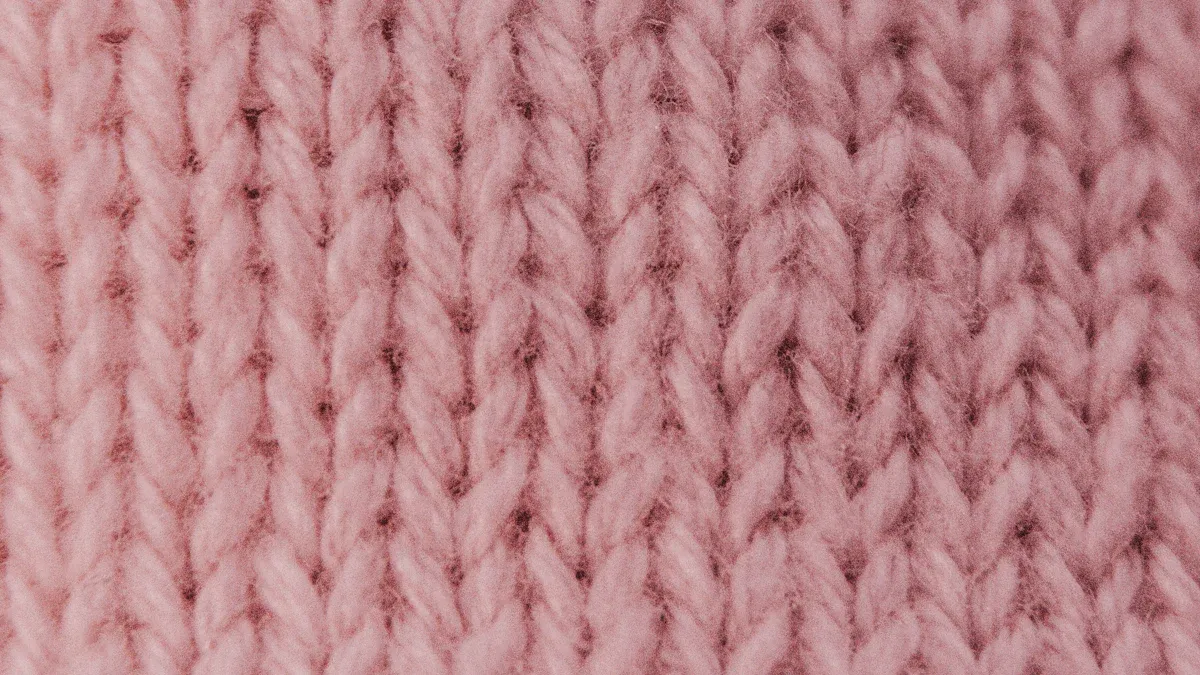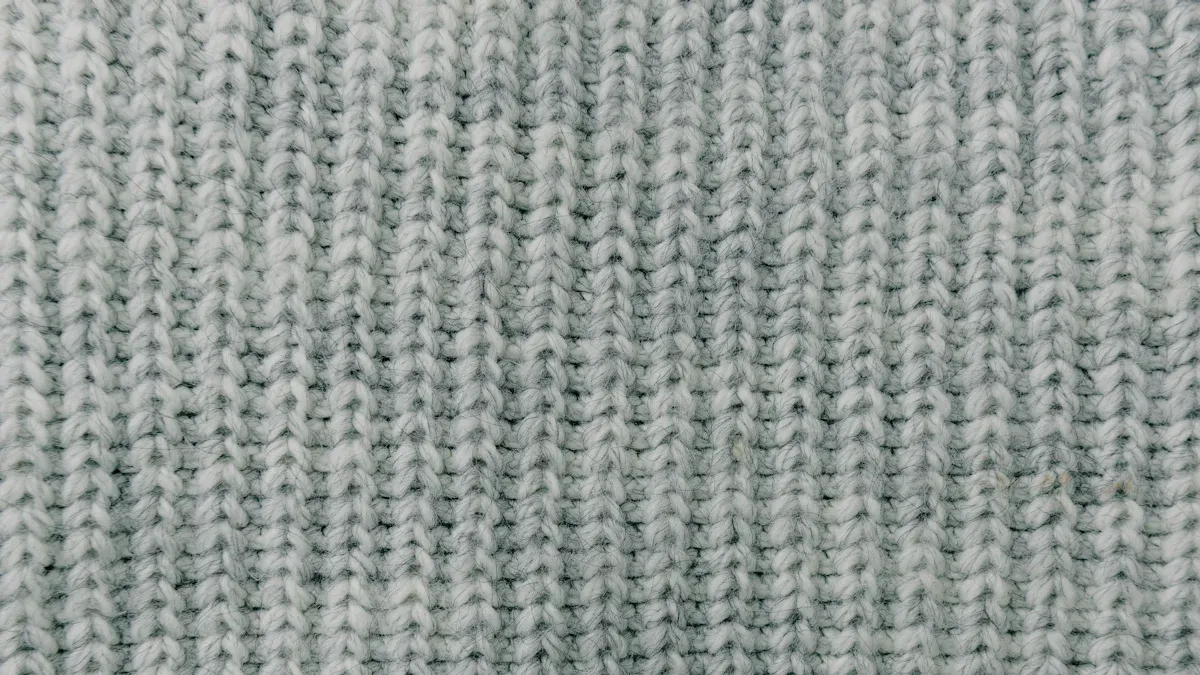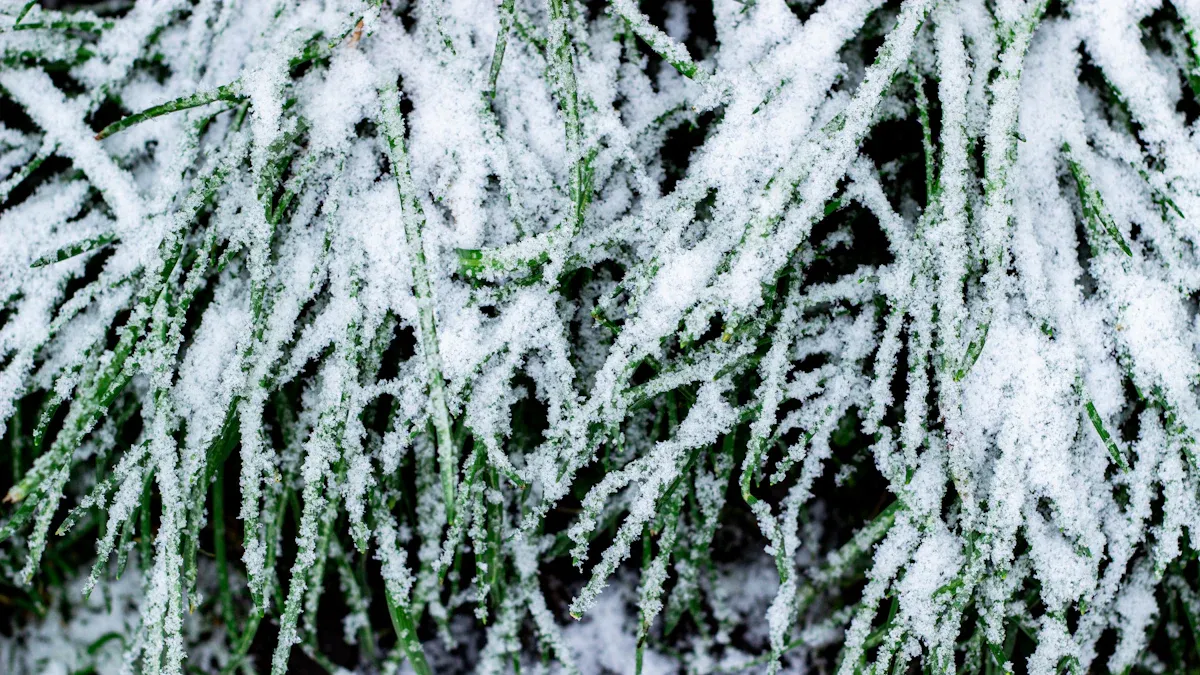
You can feel comfortable all year with seamless and knit fabrics. Some examples are merino wool, modal, lightweight wool, bamboo jersey, cotton jersey, fleece, French terry, silk knit, linen, hemp, and lycra blends. These fabrics work well in hot, cold, or changing weather. Seamless knitting makes clothes with fewer seams. This means less fabric is wasted and you feel more comfortable.
Benefit | Explanation |
|---|---|
Reduced Wastage | Less fabric is thrown away when making clothes. |
Superior Comfort | Fewer seams stop rubbing and make clothes softer on your skin. |
Durability | Clothes last longer because there are not as many weak spots. |
Design Flexibility | Makers can add cool textures and patterns more easily. |
Seamless Comfort gives you clothes that fit well, feel soft, and help the planet.
Key Takeaways
Seamless knit fabrics fit your body well. They feel soft on your skin. They have fewer seams, so your skin does not get irritated. Fewer seams mean less rubbing on your skin.
These fabrics can stretch in every direction. This lets you move easily. Your clothes also keep their shape for a long time.
Different knit fabrics are good for different weather. Cotton and bamboo are best for hot days. Merino wool and fleece are good for cold days. Blends like modal work well when the weather changes.
You can layer knit fabrics to stay comfy as weather changes. Start with a base layer that wicks away sweat. Add warm or protective layers on top.
Take care of your knit clothes the right way. Wash them gently and let them air dry. Always check the labels. This keeps your knit clothes soft and strong for many years.
Seamless Comfort Benefits
Softness and Fit
Everyone likes clothes that are soft and fit well. Seamless Comfort gives you both things. When you wear seamless knit fabrics, you feel the difference fast. These fabrics do not have thick seams, so your clothes feel smooth. The fabric can stretch in all directions, so you can move easily. Four-way stretch helps your clothes move with you when you bend or run. This gives you a close fit that does not hurt or squeeze.
Seamless knitwear fits your muscles and curves.
Special waistbands and designs help your clothes stay put.
High elastic recovery means your clothes keep their shape after many wears.
A science study looked at seamless knits and regular clothes. It found seamless clothes touch more of your skin, which can sometimes cause more friction. But the smooth surface and smart stitching help keep you comfy and steady. The way the clothes are made is more important than the fabric type. Seamless Comfort uses smart ways to make clothes soft and flexible for a long time.
Tip: Pick seamless knitwear for yoga, running, or travel. You will see less bunching and better support.
Reduced Irritation
Seamless Comfort also means less skin irritation. Raised seams in normal clothes can rub and cause chafing, especially if you move a lot or sweat. Seamless knitwear takes away these rough spots. Skin doctors say seamless clothes lower pressure marks, pain, and dryness. In one study, 80% of people with sensitive skin liked seamless clothes better because they felt less irritation and more comfort.
Seamless designs use flat surfaces and soft fibers. This keeps your skin safe from rubbing and helps stop rashes. Doctors say less friction is important for healthy skin, especially if you wear your clothes for a long time. Seamless Comfort is a smart pick for people with sensitive skin or who are active.
Benefit | How It Helps You |
|---|---|
No raised seams | Less rubbing and chafing |
Soft, stretchy fabric | Moves with your body |
Fewer pressure points | More comfort, even during activity |
Seamless Comfort gives you clothes that feel nice and protect your skin, no matter what you do.
Fabric Properties

Breathability
Breathability helps you stay cool and dry. Knit fabrics let air move through tiny spaces between the yarns. This airflow keeps your skin from feeling sticky or hot. The way a fabric is knitted matters more than the fiber itself. For example, a lightweight cotton jersey lets air pass easily, but a thick cotton knit can trap heat and sweat. Bamboo and merino wool knits stand out because they breathe well and wick moisture away from your skin. These fabrics help you stay fresh, even when you sweat. Synthetic knits like polyester can also be engineered for high breathability and quick drying.
Knit fabrics move moisture away from your skin.
Air-permeable structures let heat escape.
Moisture-wicking fibers keep you dry and comfortable.
Note: Merino wool and bamboo knits work well for both hot and cold weather because they manage moisture and temperature.
Insulation
Insulation keeps you warm when it is cold. Some knit fabrics trap air in their structure, holding heat close to your body. The type of knit and the fiber both affect how much warmth you get. Fleece and merino wool are top choices for insulation. Fleece has fluffy fibers that trap heat, while merino wool uses its natural crimp to hold air. French terry is lighter and works well for layering in mild weather.
Fabric | Insulation Features | Weight (oz/gsm) |
|---|---|---|
Fleece | Traps heat, stays warm even when wet | 10–13 oz / 340–440 gsm |
Merino Wool | Regulates temperature, keeps warmth when damp | 12–15 oz / 340–425 gsm |
French Terry | Moderate warmth, good for layering | 8–10 oz / 225–280 gsm |
Stretch
Stretch gives you freedom to move. Knit fabrics can stretch in all directions, which is called 4-way stretch. This means your clothes move with you, not against you. You feel less pressure and more comfort, especially during sports or busy days. Elastic fibers like spandex or lycra add even more stretch. Good stretch also helps your clothes keep their shape after many wears.
4-way stretch lets you bend, run, and stretch without feeling tight.
Elastic knits reduce chafing and skin irritation.
Clothes with stretch fit better and last longer.
Tip: Choose knits with 4-way stretch for activewear or travel. You will notice better comfort and support.
Best Fabrics by Climate

Warm Weather
When it gets hot, you want to stay cool and dry. Some knit fabrics help with this. Cotton jersey, bamboo jersey, silk knit, linen, and hemp are good for warm weather. These fabrics let air move through them. They also help sweat dry fast. You can feel good even if you are active.
Cotton Jersey: This fabric is soft and lets your skin breathe. Studies say 100% cotton jersey keeps you coolest and dries sweat best. You feel cooler and drier in summer or when you exercise. Cotton soaks up sweat and dries at a medium speed. That is why people like it for t-shirts and summer dresses.
Bamboo Jersey: Bamboo jersey is great for letting air in and moving sweat away. It feels soft and helps stop bad smells because it fights germs. You can wear bamboo jersey for sports or long days outside.
Linen: Linen knit fabrics let lots of air in. They help sweat dry fast. Linen can hold a lot of water before it feels wet. It dries faster than cotton. You feel cool even when it is humid.
Hemp: Hemp knits let air in and soak up sweat well. They dry at a medium speed and do not smell bad. Hemp also protects you from the sun, which is good for being outside.
Silk Knit: Silk knit feels light and smooth. It moves sweat away and dries fast. It is good for hot days or for wearing under other clothes.
🌱 Tip: Natural fibers like linen, hemp, and bamboo are good for the earth. They use less water and fewer chemicals than man-made fabrics. They help the planet and keep you cool.
Fabric | Moisture Management Rating | |
|---|---|---|
Linen | Outstanding | Excellent |
Hemp | Very Good | Good |
Bamboo | Excellent | Very Good |
You can pick these fabrics for t-shirts, tank tops, dresses, and light workout clothes. Their design and fiber type help you stay cool and comfy in the heat.
Cool Weather
When it is cold, you need fabrics that keep you warm. Merino wool, fleece, wool knits, French terry, and cashmere are best for this.
Merino Wool: Merino wool keeps you warm even if it gets wet. Its tiny fibers trap air and make you feel cozy. Merino wool also moves sweat away and does not smell bad. You can wear it for many days without washing. It is great for base layers, sweaters, and socks.
Fleece: Fleece is light and dries fast. It keeps you warm by holding air in its fluffy fibers. Fleece is good as a middle layer for outdoor fun. It lasts longer than wool but can smell after a while.
Wool Knits: Regular wool knits are warm and comfy. They keep you cozy in cold weather. You can use them for scarves, hats, and sweaters.
French Terry: French terry is lighter than fleece but still warm. It is good for layering in cool but not freezing weather.
Cashmere: Cashmere feels soft and fancy. It keeps you warm without being heavy. You can wear cashmere sweaters or scarves for warmth without bulk.
Feature | Merino Wool | Fleece (Polyester) |
|---|---|---|
Thermal Regulation | Great at keeping you warm, even if wet | Good at keeping you warm, dries fast but not as warm if wet |
Odor Resistance | Does not smell easily, good for wearing many days | Can smell after long use |
Durability | Softer, not as strong; blends make it stronger | Stronger, does not pill or stretch easily |
Weight & Packability | Heavier but you need fewer layers | Lighter and easy to pack |
❄️ Note: For best warmth, wear merino wool first and fleece on top. This keeps you warm, stops smells, and dries fast.
You can also find special knits with hollow yarns or shiny coatings. These trap air or bounce heat back to you. They give extra warmth for very cold days.
Transitional Seasons
Spring and fall have changing weather. You need fabrics that work for cool mornings and warm afternoons. Lightweight wool, modal, technical blends, and lycra knits are good for this.
Lightweight Wool: Fine merino wool keeps you warm and lets air in. It traps air for warmth but also moves sweat away. You stay comfy as the weather changes. Merino wool also stops smells and matches your body temperature.
Modal: Modal is a soft, airy knit made from beech trees. It feels smooth and moves sweat away well. You can wear modal for layers or as a base when the weather changes.
Technical Blends: Fabrics like ponte mix rayon, nylon, polyester, and spandex. They stretch in all ways, bounce back fast, and look neat. Ponte is strong, does not pill, and lets air in even though it is thick. You can wear ponte for both casual and dressy looks.
Lycra Knits: Lycra and other stretchy fibers help clothes move with you and keep their shape. Some blends use fibers like XLANCE®, which do not get damaged by the sun and work well when the weather changes.
Property / Aspect | XLANCE® Fiber | |
|---|---|---|
Elasticity & Recovery | Stretches and bounces back very well | Stretches and bounces back well |
UV Resistance | Okay protection from the sun | Great protection from the sun |
Heat Setting Efficiency | Works best at high heat | Works best at lower heat |
🍂 Tip: Pick performance knits with stretch and sweat-wicking for changing weather. These fabrics help you feel good all day.
You can wear lightweight wool or modal under a ponte jacket or lycra-blend hoodie. This lets you change your outfit as the weather changes. These fabrics do not wrinkle and are easy to wash, so they are great for travel or busy days.
Choosing Knits
Weight and Construction
When you pick knit fabrics, you need to think about weight and how the fabric is made. The right choice helps you stay comfortable in any climate or activity.
Lightweight knits (up to 4 oz/yd² or 130 gsm) feel soft and drapey. You can use them for t-shirts or scarves in warm weather.
Medium-weight knits (4–9 oz/yd² or 130–300 gsm) work well for dresses and skirts. They balance stretch and support, making them good for mild weather.
Heavyweight knits (over 9 oz/yd² or 300+ gsm) are best for pants and jackets. They give you more warmth and last longer in cold or rough conditions.
Knit Fabric Weight | Weight Range | Best Use | Construction Features |
|---|---|---|---|
Lightweight | Up to 4 oz/yd² | T-shirts, scarves | Soft, drapey, great for hot weather |
Medium Weight | 4–9 oz/yd² | Dresses, skirts | Balanced stretch, good for many activities |
Heavyweight | 9+ oz/yd² | Pants, jackets | Durable, warm, best for cold or tough use |
Warp knits give you strength and less stretch, so they work for jackets or pants. Weft knits stretch more and feel softer, making them good for tops and activewear. You should match the fabric weight and construction to your climate and what you plan to do.
Layering
Layering helps you stay comfortable when the weather changes. You can use different knit fabrics for each layer:
Start with a base layer that wicks away sweat. Merino wool or synthetic blends work well here.
Add a mid layer for warmth. Fleece or thicker knits trap heat but stay light.
Finish with an outer layer that blocks wind or rain. Choose a breathable, weather-proof fabric.
Tip: Thin knits make great base layers in spring or fall. Sweater vests and turtlenecks add warmth without making you feel bulky.
You can adjust your layers as the temperature changes. For hot days, wear just the base layer. For cold days, add more layers to keep warm.
Care Tips
Taking care of your knit fabrics keeps them soft and strong. You can make your clothes last longer with a few simple steps:
Wash less often, especially wool. Airing out your clothes removes odors and saves water.
Use gentle wash settings and cool water. This protects fibers like merino wool and modal from shrinking or damage.
Never tumble dry knits. Lay them flat to dry and keep them away from direct heat or sunlight.
For stains, use a gentle remover and cool water. Avoid scrubbing hard.
Steam your knits to refresh them and remove wrinkles.
Note: Always check the care label before washing. Proper care helps your knits keep their shape, color, and comfort for years.
Seamless Comfort lets you pick clothes for any weather. You can wear Merino wool, Pima cotton, or organic bamboo. These fabrics keep you warm or let your skin breathe. Seamless knitting helps clothes fit well and last a long time. These fabrics can stretch and move with you. They also help keep sweat away and block the sun. Choosing seamless knitwear is good for the earth. It makes less waste and uses fewer materials.
Try Seamless Comfort to feel good all year and help the planet.
Works for hot or cold days
Makes less waste when made
Feels soft, stretches, and is simple to wash
FAQ
What makes seamless knit fabrics better for sensitive skin?
Seamless knit fabrics do not have raised seams. You feel less rubbing and fewer pressure points. Your skin stays safe from chafing. Many people with sensitive skin choose seamless knits for daily comfort.
Can you wear knit fabrics in both hot and cold weather?
Yes, you can. Lightweight knits like cotton jersey or bamboo keep you cool in summer. Merino wool or fleece keeps you warm in winter. You can layer different knits for changing weather.
How do you wash and care for seamless knitwear?
Always check the care label. Use cool water and a gentle cycle. Lay your clothes flat to dry. Do not use high heat. This keeps your knitwear soft and helps it last longer.
Are seamless knits good for sports and travel?
Yes! Seamless knits stretch in all directions. You move easily and stay comfortable. These fabrics wick away sweat and dry fast. Many travelers and athletes pick seamless knits for these reasons.
Do seamless knit fabrics help the environment?
Seamless knitting creates less fabric waste. Many knits use natural or recycled fibers. You help the planet by choosing seamless knitwear. Look for brands that use eco-friendly materials and processes.









